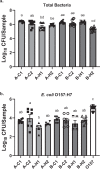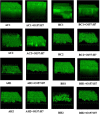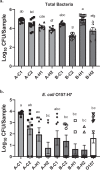Impact of mixed biofilm formation with environmental microorganisms on E. coli O157:H7 survival against sanitization
- PMID: 33083548
- PMCID: PMC7560865
- DOI: 10.1038/s41538-020-00076-x
Impact of mixed biofilm formation with environmental microorganisms on E. coli O157:H7 survival against sanitization
Abstract
Biofilm formation by foodborne pathogens is a serious threat to food safety and public health. Meat processing plants may harbor various microorganisms and occasional foodborne pathogens; thus, the environmental microbial community might impact pathogen survival via mixed biofilm formation. We collected floor drain samples from two beef plants with different E. coli O157:H7 prevalence history and investigated the effects of the environmental microorganisms on pathogen sanitizer tolerance. The results showed that biofilm forming ability and bacterial species composition varied considerably based on the plants and drain locations. E. coli O157:H7 cells obtained significantly higher sanitizer tolerance in mixed biofilms by samples from the plant with recurrent E. coli O157:H7 prevalence than those mixed with samples from the other plant. The mixed biofilm that best protected E. coli O157:H7 also had the highest species diversity. The percentages of the species were altered significantly after sanitization, suggesting that the community composition affects the role and tolerance level of each individual species. Therefore, the unique environmental microbial community, their ability to form biofilms on contact surfaces and the interspecies interactions all play roles in E. coli O157:H7 persistence by either enhancing or reducing pathogen survival within the biofilm community.
Keywords: Biofilms; Industrial microbiology.
© This is a U.S. government work and not under copyright protection in the U.S.; foreign copyright protection may apply 2020.
Conflict of interest statement
Competing interestsThe authors declare no competing interests.
Figures






Similar articles
-
Effectiveness and Functional Mechanism of a Multicomponent Sanitizer against Biofilms Formed by Escherichia coli O157:H7 and Five Salmonella Serotypes Prevalent in the Meat Industry.J Food Prot. 2020 Apr 1;83(4):568-575. doi: 10.4315/0362-028X.JFP-19-393. J Food Prot. 2020. PMID: 32221560
-
Biofilm formation and sanitizer resistance of Escherichia coli O157:H7 strains isolated from "high event period" meat contamination.J Food Prot. 2014 Nov;77(11):1982-7. doi: 10.4315/0362-028X.JFP-14-253. J Food Prot. 2014. PMID: 25364934
-
Escherichia coli O157:H7 Strains Isolated from High-Event Period Beef Contamination Have Strong Biofilm-Forming Ability and Low Sanitizer Susceptibility, Which Are Associated with High pO157 Plasmid Copy Number.J Food Prot. 2016 Nov;79(11):1875-1883. doi: 10.4315/0362-028X.JFP-16-113. J Food Prot. 2016. PMID: 28221917
-
Biofilms and Meat Safety: A Mini-Review.J Food Prot. 2019 Jan;82(1):120-127. doi: 10.4315/0362-028X.JFP-18-311. J Food Prot. 2019. PMID: 30702946 Review.
-
Strategies for Biofilm Inhibition and Virulence Attenuation of Foodborne Pathogen-Escherichia coli O157:H7.Curr Microbiol. 2017 Dec;74(12):1477-1489. doi: 10.1007/s00284-017-1314-y. Epub 2017 Jul 25. Curr Microbiol. 2017. PMID: 28744570 Review.
Cited by
-
SARS-CoV-2 Delta variant remains viable in environmental biofilms found in meat packaging plants.PLoS One. 2024 Jun 13;19(6):e0304504. doi: 10.1371/journal.pone.0304504. eCollection 2024. PLoS One. 2024. PMID: 38870232 Free PMC article.
-
Liposomes-Based Drug Delivery Systems of Anti-Biofilm Agents to Combat Bacterial Biofilm Formation.Antibiotics (Basel). 2023 May 8;12(5):875. doi: 10.3390/antibiotics12050875. Antibiotics (Basel). 2023. PMID: 37237778 Free PMC article. Review.
-
Escherichia coli has an undiscovered ability to inhibit the growth of both Gram-negative and Gram-positive bacteria.Sci Rep. 2024 Mar 28;14(1):7420. doi: 10.1038/s41598-024-57996-x. Sci Rep. 2024. PMID: 38548840 Free PMC article.
-
Repeated biocide treatments cause changes to the microbiome of a food industry floor drain biofilm model.Front Microbiol. 2025 Mar 14;16:1542193. doi: 10.3389/fmicb.2025.1542193. eCollection 2025. Front Microbiol. 2025. PMID: 40160267 Free PMC article.
-
Characterization of multispecies microbial communities at beef and pork processing plants and their impact on pathogen stress tolerance.Front Microbiol. 2025 Jul 2;16:1605719. doi: 10.3389/fmicb.2025.1605719. eCollection 2025. Front Microbiol. 2025. PMID: 40673151 Free PMC article.
References
-
- Wang R, Kalchayanand N, Schmidt JW, Harhay DM. Mixed biofilm formation by Shiga toxin-producing Escherichia coli and Salmonella enterica serovar Typhimurium enhanced bacterial resistance to sanitization due to extracellular polymeric substances. J. Food Prot. 2013;76:1513–1522. doi: 10.4315/0362-028X.JFP-13-077. - DOI - PubMed
-
- Chitlapilly Dass S, Abu-Ghannam N, Antony-Babu S, Cummins JE. Ecology and molecular typing of L. monocytogenes in a processing plant for cold-smoked salmon in the Republic of Ireland. Food Res. Int. 2010;43:1529–1536. doi: 10.1016/j.foodres.2010.04.030. - DOI
LinkOut - more resources
Full Text Sources

